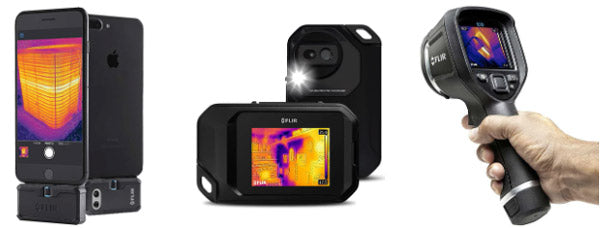What is Thermography?
Thermography is a non-contact method of measuring and then interpreting the temperature of an object or scene. It involves using a thermal camera to capture images in the infrared spectrum. These thermal images are then analysed to identify potential hot spots or anomalies. Thermography is used in many applications, including building inspection, medical imaging, and industrial processes.
Infrared (IR) radiation refers to wavelengths on the electromagnetic spectrum that are longer than visible light. In the same way that you cannot see radio waves, you can't see infrared with the naked eye.
You'll notice in the graphic above that infrared has nothing to do with x-rays, a type of short-wave radiation. For this reason, you can't see through an object with a thermographic camera. Although, it often does appear that way, as you'll see in some of the videos below.
A thermographic camera or thermal scanner is a device that captures images in infrared. This is unlike a regular digital or film camera which can only reproduce the world as we see it - in the visual spectrum.
Three styles of infrared cameras.
Free Online Thermography Training
The following video, Basics of Infrared Thermography, goes for 25 minutes.
It highlights a wide range of use cases for thermography. In the process, you can glean some of the most critical thermography training concepts.
The Infrared Training Center, the paid-for training arm of FLIR, produced the video. As such, it's a bit of a sales pitch for their multi-day infrared training courses, which the vast majority of our customers do not require.
As you'll see in the above video, the visual and thermal worlds can look very different. For example, the visually-vivid photo in the trainer's lobby comes up blank on a thermal camera - except for a handprint where someone has recently touched the wall. The trainer forgets to mention this key point (and explain the presence of the handprint) in the video!
Here are some key takeaway messages from the above thermography training video:
- The heat capacitance of an object (how it responds to and stores thermal energy) affects its thermal signature.
- The colour of an object does not necessarily affect things in the infrared spectrum.
- Even ice and snow emit detectable thermal energy.
- Materials with different moisture content radiate differently.
- Emissivity is a crucial concept in thermography - more on this below.
- A thermal camera cannot see through physical objects, including glass windows.
- You can see through some things in infrared that you can't see through visually (like smoke).
- Thermal resolution is a critical specification for thermographic cameras. The higher the resolution, the further you can see (all else being equal).
At about 9 minutes into the video, the trainer outlines a range of useful thermography applications. These include: detecting electrical hot spots, inspecting motors, tank levels, values, belt drives, insulation, air conditioning vents, water leaks, manufacturing applications, and more.
From about 16 minutes onwards, the video dials up the sales pitch and includes a few more useful examples.
Thermal Emissivity
The following short video helps explain the important concept of emissivity.
Emissivity describes the ability of an object to emit thermal radiation. It's a setting you can manually adjust - even on our lower-cost thermal cameras like the FLIR One.
To adjust emissivity settings and correct them, you need to know how it works. This video shows how to overcome accuracy issues when measuring shiny metal objects - or other reflective surfaces.
Thermography Training Australia
FLIR - the manufacturer of the thermographic cameras that we sell - offers a half-day basic infrared training course. You can book this FLIR training here.
FLIR's Infrared Training Center (ITC) and some other institutions also offer much more in-depth multi-day training courses. We are not involved in the sale or delivery of this higher-end thermography training.
If you haven't already, it's probably time to get your hands on a thermal camera. They are now relatively affordable and accessible to most trades, professions, and even home hobbyists.















